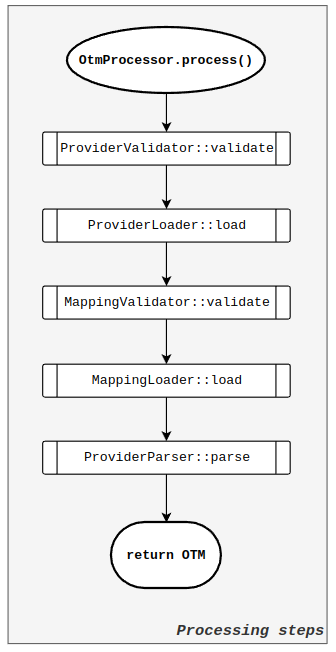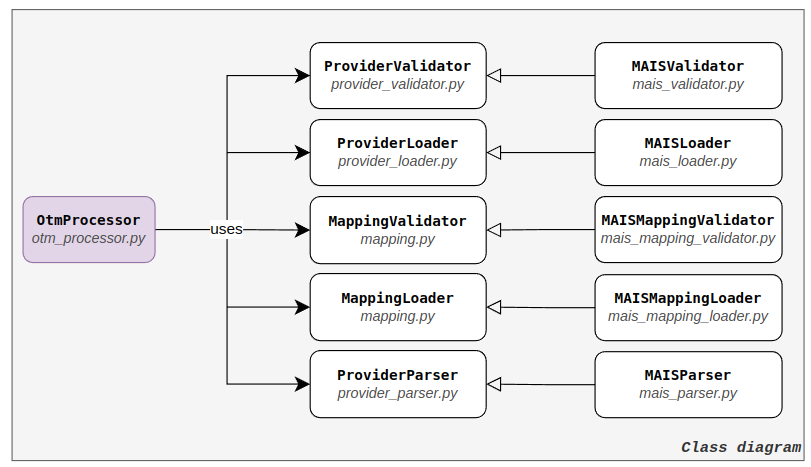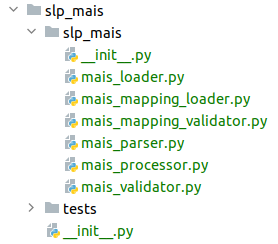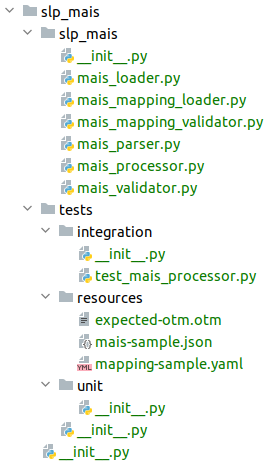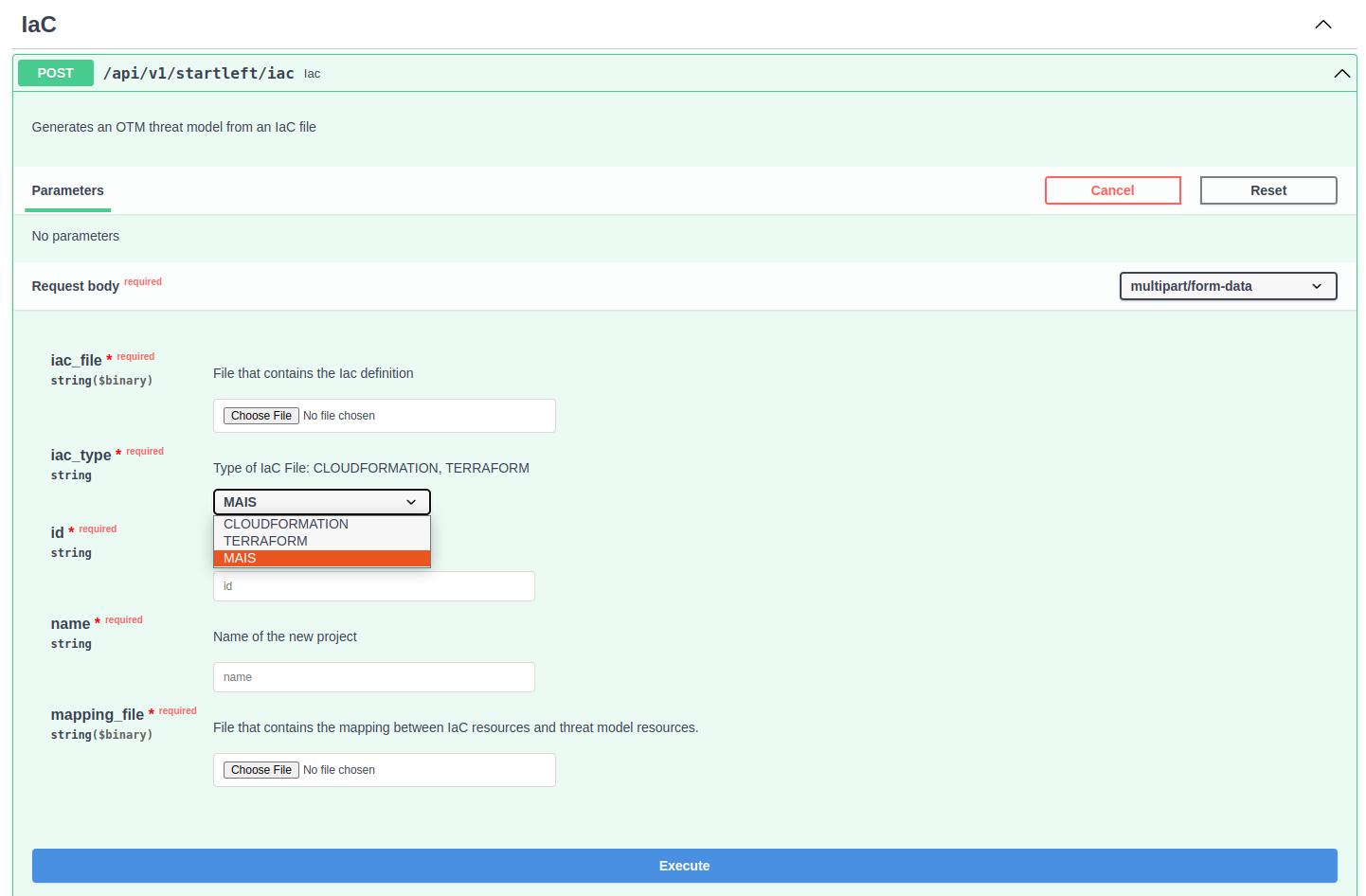Create a new StartLeft Processor (SLP)
As you can see in the architecture page StartLeft Processors (SLPs) are a special kind of
modules
where the conversion into OTM logic is actually implemented. All of them are based on the same interfaces, defined in the
slp_base module. So, if you want to create a new SLP, you simply have to:
- Create your module extending
slp_base. - Implement the parsing logic in your module.
- Configure StartLeft to use your module.
Below you have a guided tutorial for easily performing this steps and creating a new SLP for a very basic invented input format that you can use as a base for building your own.
Defining a sample input format (for demo purposes)
Note: The SLPs are classified in IaC, Diagram or External Threat Model (ETM). However, it is only a logical division and the instructions defined in this tutorial are valid for creating SLPs of any kind.
To guide this tutorial, let's imagine a fictitious Infrastructure as Code format, that we will call My Awesome Infrastructure Source (MAIS). A sample file of this format could be something like:
We need to define a format for the mappings between the source file and OTM. An example of this mapping file could be:
Note: Remind that the OTM standard forces each component to have a parent. This is the reason we include this default TrustZone for this example.
So the resulting OTM for this example should be something like:
{
"otmVersion": "0.1.0",
"project": {
"name": "My Project",
"id": "my-project"
},
"representations": [
{
"name": "My Awesome Infrastructure Source",
"id": "My Awesome Infrastructure Source",
"type": "code"
}
],
"trustZones": [
{
"id": "public-cloud",
"name": "Public Cloud",
"risk": {
"trustRating": 10
}
}
],
"components": [
{
"id": "1",
"name": "My Server",
"type": "otm-server",
"parent": {
"trustZone": "public-cloud"
}
}
],
"dataflows": []
}
Understanding the slp_base interfaces
The OTMProcessor class inside the slp_base module defines the conversion process using a template method, whose behavior depends on the implementations
of the rest of the interfaces in the module.
In order to implement our sample processor, we need to know the structure of the provided interfaces, which looks like this.
Creating the module
For this tutorial, we are going to create a new SLP for parsing My awesome input source (MAIS) files which is going to be called
slp_mais. First, we need to set up our development environment as explained in the Quickstart Guide for Developers.
Build the module structure
Note: Do not worry if at this point you get some errors from the IDE. We will create some required modules and classes later.
Every module must have a common structure and minimum files to work. So let's start by creating them.
-
Create the module folder
slp_maisunder the rootstartleftrepo folder: -
Override the module importer for the module (for preventing forbidden imports among modules) by creating a
slp_mais/__init__.pyfile with this content:###################################################################### # This folder is not actually intended to be a regular package # # HOWEVER, we need to keep this __init.py__ file in order to # # make it visible by other modules. # # In future versions, this package should be moved to a lib so # # that it will be an independent module instead of a "false" package # ###################################################################### # DON'T REMOVE: Module importer overwritten to prevent bidirectional dependencies from _sl_build.secure_importer import override_module_importer override_module_importer() from .slp_mais import * -
Create the production code package, creating a folder
slp_mais/slp_maiswith an__init__.pyfile that exports the processor we are going to create in the next steps: -
Create the test code module as a
slp_mais/testsfolder with an empty__init__.pyinside it. -
Create packages for unit and integration tests:
slp_mais/tests/unitwith an empty__init__.pyfile inside it.slp_mais/tests/integrationwith an empty__init__.pyfile inside it.
-
Create an empty
slp_mais/tests/resourcesfolder.
After following these steps, your module should like this:
Add the MAIS type to the Provider types
Every source type supported by StartLeft must be included in the enums contained in slp_base/slp_base/provider_type.py.
As we have stated before, MAIS is a fictitious IaC source, so we will add it to the IacType enum.
from otm.otm.provider import Provider
class IacType(str, Provider):
# [...]
MAIS = ("MAIS", "My Awesome Infrastructure Source", "code")
Implement slp_base interfaces
Note: In order to simplify this tutorial, we will not implement any validation nor process loading or processing errors, but, for a real implementation, you must read the errors management page to know the errors you should raise in each stage of the conversion process.
We already know the main structure of the conversion process, so we can create our own implementation classes in the production
code package (slp_mais/slp_mais).
MAISValidator (ProviderValidator)
Create the mais_validator.py file with the MAISValidator class implementing ProviderValidator.
import logging
from slp_base import ProviderValidator
logger = logging.getLogger(__name__)
class MAISValidator(ProviderValidator):
def __init__(self, mais_data):
super(MAISValidator, self).__init__()
self.mais_data = mais_data
def validate(self):
logger.info('Validating MAIS file')
MAISLoader (ProviderLoader)
Create the mais_loader.py file with the MAISLoader class implementing ProviderLoader:
import json
import logging
from slp_base.slp_base.provider_loader import ProviderLoader
logger = logging.getLogger(__name__)
class MAISLoader(ProviderLoader):
def __init__(self, mais_source):
self.mais_source = mais_source
self.mais = {}
def load(self):
logging.getLogger('Loading MAIS source...')
self.mais = json.loads(self.mais_source)
def get_mais(self) -> {}:
return self.mais
MAISMappingValidator (MappingValidator)
Create the mais_mapping_validator.py file with the MAISMappingValidator class implementing MappingValidator:
import logging
from slp_base import MappingValidator
logger = logging.getLogger(__name__)
class MAISMappingValidator(MappingValidator):
def __init__(self, mais_mapping_file):
self.mais_mapping_file = mais_mapping_file
def validate(self):
logger.info('Validating MAIS mapping file')
MAISMappingLoader (MAISMappingLoader)
Create the mais_mapping_loader.py file with the MAISMappingLoader class implementing MAISMappingLoader:
import yaml
import logging
from slp_base import MappingLoader
logger = logging.getLogger(__name__)
class MAISMappingLoader(MappingLoader):
def __init__(self, mapping_data: bytes):
self.mapping_data = mapping_data
self.mais_mapping = {}
def load(self):
logger.info("Loading MAIS mapping file...")
self.mais_mapping = yaml.load(self.mapping_data, Loader=yaml.SafeLoader)
def get_mais_mapping(self):
return self.mais_mapping
MAISParser (ProviderParser)
Create mais_parser.py file with the MAISParser class implementing ProviderParser. It will need to contain,
at least, the minimum information to parse the source and create the OTM, this is:
- The ID of the OTM project.
- The name of the OTM project.
- The MAIS source.
- The MAIS mappings.
For this example, almost trivial logic for processing our imaginary format is included, but this is the class where you would need to actually implement your custom conversion process.
from otm.otm.entity.component import Component
from otm.otm.entity.otm import OTM
from otm.otm.entity.trustzone import Trustzone
from otm.otm.otm_builder import OTMBuilder
from slp_base.slp_base.provider_parser import ProviderParser
from slp_base.slp_base.provider_type import IacType
class MAISParser(ProviderParser):
def __init__(self, project_id: str, project_name: str, source, mais_mapping):
self.project_id = project_id
self.project_name = project_name
self.source = source
self.mais_mapping = mais_mapping
def build_otm(self) -> OTM:
return OTMBuilder(self.project_id, self.project_name, IacType.MAIS)
.add_components(self.__parse_components())
.add_trustzones(self.__parse_trustzones())
.build()
def __parse_trustzones(self) -> [Trustzone]:
default_trustzone = self.__get_default_trustzone()
return [Trustzone(default_trustzone['id'], default_trustzone['name'])]
def __parse_components(self) -> [Component]:
component_mappings = self.mais_mapping['components']
types_mappings = dict(zip(
[cm['source_type'] for cm in component_mappings],
component_mappings))
otm_components = []
for mais_component in self.source['resources']:
source_type = mais_component['type']
if source_type not in types_mappings:
continue
otm_components.append(Component(
id=str(mais_component['id']),
name=mais_component['name'],
type=types_mappings[source_type]['otm_type'],
parent=self.__get_default_trustzone()['id'],
parent_type='trustZone'
))
return otm_components
def __get_default_trustzone(self) -> dict:
return next(filter(lambda tz: 'default' in tz and tz['default'], self.mais_mapping['trustZones']))
MAISProcessor (OTMProcessor)
Finally, we are going to create the main class, the MAISProcessor, in a mais_processor.py file for implementing the
OTMProcessor interface. This class must implement methods for retrieving instances of all the other classes created above:
from slp_base import MappingLoader, MappingValidator
from slp_base import OTMProcessor
from slp_base import ProviderValidator
from slp_base.slp_base.provider_loader import ProviderLoader
from slp_base.slp_base.provider_parser import ProviderParser
from slp_mais.slp_mais.mais_loader import MAISLoader
from slp_mais.slp_mais.mais_mapping_loader import MAISMappingLoader
from slp_mais.slp_mais.mais_mapping_validator import MAISMappingValidator
from slp_mais.slp_mais.mais_parser import MAISParser
from slp_mais.slp_mais.mais_validator import MAISValidator
class MAISProcessor(OTMProcessor):
def __init__(self, project_id: str, project_name: str, sources: [bytes], mappings: [bytes]):
self.project_id = project_id
self.project_name = project_name
self.source = sources[0]
self.mappings = mappings[0]
self.loader = None
self.mapping_loader = None
def get_provider_validator(self) -> ProviderValidator:
return MAISValidator(self.source)
def get_provider_loader(self) -> ProviderLoader:
self.loader = MAISLoader(self.source)
return self.loader
def get_mapping_validator(self) -> MappingValidator:
return MAISMappingValidator(self.mappings)
def get_mapping_loader(self) -> MappingLoader:
self.mapping_loader = MAISMappingLoader(self.mappings)
return self.mapping_loader
def get_provider_parser(self) -> ProviderParser:
mais = self.loader.get_mais()
mais_mapping = self.mapping_loader.get_mais_mapping()
return MAISParser(self.project_id, self.project_name, mais, mais_mapping)
Once you have created all the implementations, your slp_module package should appear like this:
Testing the SLP
We have already implemented all the necessary classes to perform the conversion from MAIS to OTM, so let's create a test to verify that they are working fine.
Create the test resources
We are going to create a single happy path test using the resources from the section where the MAIS format is defined.
So, inside the slp_mais/tests/resources folder:
- Copy the MAIS source file with the name
mais-sample.json. - Copy the mapping file with the name
mapping-sample.yaml. - Copy the expected OTM resulting file with the name
expected-otm.otm.
Implement the test
Now we can create a simple test that verifies that the conversion process is working fine for the basic files created above. For that,
create a test_mais_processor.py file inside the slp_mais/slp_mais/tests/integration folder:
import os
from sl_util.sl_util.file_utils import get_byte_data
from slp_base.tests.util.otm import validate_and_compare
from slp_mais.slp_mais.mais_processor import MAISProcessor
SAMPLE_PROJECT_ID = 'my-project'
SAMPLE_PROJECT_NAME = 'My Project'
resources_path = f'{os.path.dirname(__file__)}/../resources'
class TestMAISProcessor:
def test_single_component_mais_file_ok(self):
# GIVEN a simple MAIS file with a single component
mais_file = get_byte_data(f'{resources_path}/mais-sample.json')
# AND a MAIS mapping file that defines a mapping for that component
mapping_file = get_byte_data(f'{resources_path}/mapping-sample.yaml')
# AND an expected OTM result
expected_otm = f'{resources_path}/expected-otm.otm'
# WHEN MAISProcessor::process is invoked
otm = MAISProcessor(
project_id=SAMPLE_PROJECT_ID,
project_name=SAMPLE_PROJECT_NAME,
sources=[mais_file],
mappings=[mapping_file]
).process()
# THEN a valid OTM file matching expected is generated
result, expected = validate_and_compare(otm, expected_otm, [])
assert result == expected
The whole module appears now like this:
You are done! Execute the test and verify that the conversion process is happily performed!
Configuring and exposing the SLP
At this point we already have our processor up and running, so it is time to expose it. For that, no code is needed, and you only need to perform the configuration steps below.
Configure the module
- Go to the
_sl_build/modules.pyclass, where you can find the modules' configuration. - Create a new entry in the array with the configuration for our
slp_maismodule:
Update the Swagger schema
- Open the file
startleft/resources/api/v1/swagger.yamlwhere the API is defined. - Add the new MAIS type to the
iac_typedescription and to theIacTypeenum:
Try it on the REST API
Launch the REST API as explained in the Quickstart Guide for Developers
and check the Swagger page in http://localhost:5000/docs. You can see that the MAIS IaC
type is already available in the POST /iac endpoint:
If you try to perform the request with the sample source and mapping files used across this tutorial, you can see that the server is returning the expected OTM as a response.
